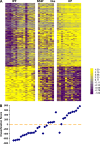Gene expression profiles distinguish idiopathic pulmonary fibrosis from hypersensitivity pneumonitis
- PMID: 16166619
- PMCID: PMC2662988
- DOI: 10.1164/rccm.200504-644OC
Gene expression profiles distinguish idiopathic pulmonary fibrosis from hypersensitivity pneumonitis
Abstract
Rationale: Many of the interstitial lung diseases represent a diagnostic and therapeutic challenge because their clinical and even histologic features are often nonspecific. Likewise, the transcriptional signatures of most of them are unknown.
Objective: To compare the gene expression patterns from patients with idiopathic pulmonary fibrosis (IPF) hypersensitivity pneumonitis (HP), and nonspecific interstitial pneumonia (NSIP) using custom oligonucleotide microarrays.
Methods: We profiled lung biopsies from 15 patients with IPF, 12 with HP, and eight with NSIP. Labeled complementary ribonucleic acid was hybridized to a custom Affymetrix oligonucleotide DNA microarray using standard Affymetrix protocols. The custom array, Hu03, contained 59,619 probe sets representing an estimated 46,000 gene clusters.
Results: We identified statistically significant gene expression signatures that characterize HP and IPF. The HP gene expression signature was enriched for genes that are functionally associated with inflammation, T-cell activation, and immune responses, whereas the IPF signature was characterized by the expression of tissue remodeling, epithelial, and myofibroblast genes. We then compared these gene expression signatures to classify NSIP, a histologic pattern that is often difficult to differentiate consistently from HP and IPF. Two cases exhibited an IPF-like gene expression, another one could be more properly classified as HP, whereas others did not resemble HP or IPF, suggesting that they may represent idiopathic NSIP.
Conclusions: Our results underscore the value of gene expression signatures to classify the interstitial lung diseases and to understand pathogenic mechanisms, and suggest new ways to improve the diagnosis and treatment of patients with these diseases.
Figures





Comment in
-
Classification of interstitial pneumonias: what do gene expression profiles tell us?Am J Respir Crit Care Med. 2006 Jan 15;173(2):141-2. doi: 10.1164/rccm.2510004. Am J Respir Crit Care Med. 2006. PMID: 16391303 No abstract available.
References
-
- Schwarz ML, King TE, Raghu G. Approach to the evaluation and diagnosis of interstitial lung disease. In: King TE, Schwarz ML, editors. Interstitial lung disease. Ontario, BC, Canada: B.C. Decker; 2003. pp. 1–30.
-
- American Thoracic Society/European Respiratory Society. American Thoracic Society/European Respiratory Society international multidisciplinary classification of the idiopathic interstitial pneumonias. Am J Respir Crit Care Med 2002;165:277–304. - PubMed
-
- Katzenstein ALA, Myers JL. Idiopathic pulmonary fibrosis: clinical relevance of pathologic classification. Am J Respir Crit Care Med 1998;157:1301–1315. - PubMed
-
- Nicholson AG, Colby TV, du Bois RM, Hansell DM, Wells AU. The prognostic significance of the histologic pattern of interstitial pneumonia in patients presenting with the clinical entity of cryptogenic fibrosing alveolitis. Am J Respir Crit Care Med 2000;162:2213–2217. - PubMed
-
- Patel AM, Ryu JH, Reed CE. Hypersensitivity pneumonitis: current concepts and future questions. J Allergy Clin Immunol 2001;108:661–670. - PubMed
Publication types
MeSH terms
Grants and funding
LinkOut - more resources
Full Text Sources
Other Literature Sources
Medical
Research Materials
Miscellaneous

